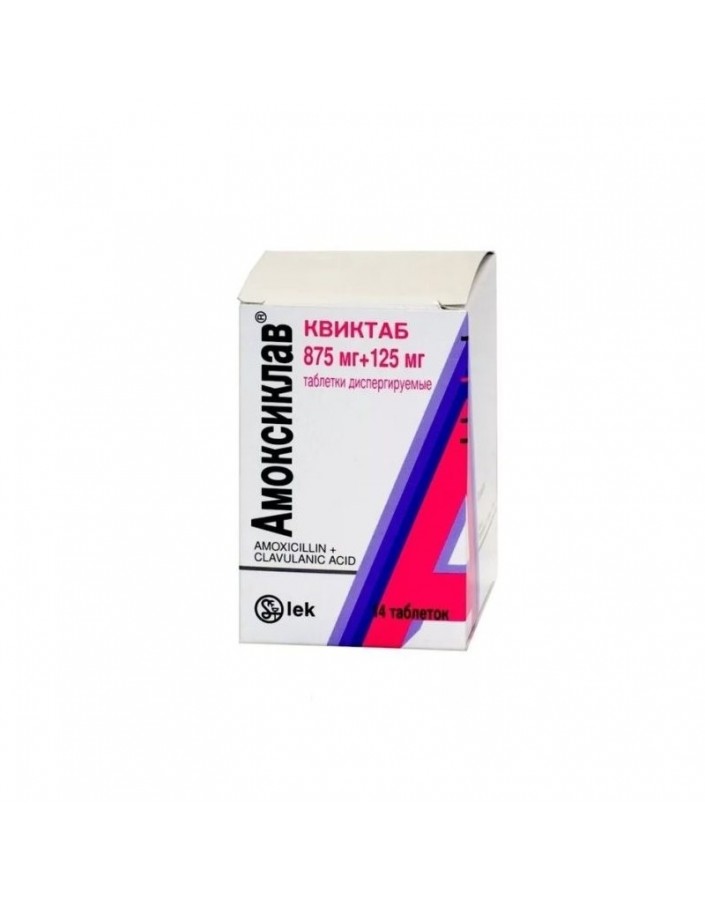




Security policy (edit with Customer reassurance module)

Delivery policy (edit with Customer reassurance module)

Return policy (edit with Customer reassurance module)
Dispersible pills light yellow color with brown splashes, oblong, octagonal, with a fruity odor.
1 pill of 875 mg contains Amoxicillin (as a trihydrate) and clavulanic acid (as a potassium salt) 125 mg;
Excipients: tropical flavor, sweet orange flavor, aspartame, anhydrous colloidal silicon dioxide, iron (III) yellow oxide (E172), talc, castor oil, hydrogenated, microcrystalline silicon-containing cellulose.
14 pcs. packaged.
Amoxiclav Quiktab is a broad-spectrum antibiotic; contains semi-synthetic penicillin amoxicillin and b-lactamase inhibitor clavulanic acid. Clavulanic acid inhibits most clinically significant b-lactamases (types 2, 3, 4, and 5 according to the Richmond Sykes classification) produced by Staphylococcus spp., Escherichia coli, Proteus mirabilis, Haemophilus influenzae, Moraxella catarrhalis, Bacteroides spp. Inactive against b-lactamase type 1, produced by Enterobacter spp., Morganella morganii, Pseudomonas aeruginosa, Serratia spp., Acinetobacter spp.
This combination provides a high bactericidal activity of Amoxiclav (including in relation to amoxicillin-resistant microorganism strains). Clavulanic acid, having a higher affinity for b-lactamase than amoxicillin, forms a stable deactivated complex with the enzyme, preventing the enzymatic degradation of amoxicillin under the action of b-lactamase.
Thus, Amoxiclav acts bactericidal on a wide range of gram-positive and gram-negative bacteria (including strains that have become resistant to beta-lactam antibiotics due to the production of b-lactamase).
Amoxiclav active against aerobic gram-positive bacteria: Streptococcus spp. (including Streptococcus pneumoniae, Streptococcus viridans, Streptococcus milleri, ryptows rye, Streptococcus pyogenes, Streptococcus bovis), Enterococcus faecium, Staphylococcus aureus (except for methicillin-resistant strains), Staphylococcus epitheypoury, aureus, Staphylococcus aureus (except methicillin-resistant strains), Staphylococcus epitheypoury, aureus, Staphylococcus aureus (except methicillin-resistant strains), Staphylococcus epitheypush, p'eurectus, aureus (except methicillin-resistant strains), Staphylococcus epiderheypush, apycarty, aureus, Staphylococcus aureus (except methicillin-resistant strains) monocytogenes, Nocardia asteroides; aerobic gram-negative bacteria: Aeromonas spp., Bordetella pertussis, Brucella spp., Campylobacter jejuni, Campylobacter coli, Citrobacter spp. (moderately sensitive), Escherichia coli, Gardnerella vaginalis, Haemophilus ducreyi, Haemophilus influenzae, Helicobacter pylori, Klebsiella spp., Legionella pneumophila, Moraxella catarrhalis, Morganella spp. (moderately sensitive), Neisseria gonorrhoeae, Neisseria meningitidis, Pasteurella multocida, Proteus mirabilis, Proteus vulgaris, Providencia spp., Salmonella spp., Shigella spp., Vibrio cholerae, Yersinia enterocolitica (Shigella spp., Vibrio cholerae, Yersinia enterocolitica (Shigella spp., Vibrio cholerae, Yersinia enterocolitica (Shigella spp., Vibrio cholerae, Yersinia enterocolitica (Shigella spp., Vibrio cholerae, Yersinia enterocolitica (Shigella spp., Vibrio cholerae, Yersinia enterocolitica (Shigella spp., Vibrio cholerae, Yersinia enterocolitica (Shigella spp., Vibrio cholerae, Yersinia enterocolitica) anaerobic bacteria: Actinomyces israelii, Bacteroides spp. (including Bacteroides fragilis), Prevotella melaninogenica, Clostridium spp. (except Clostridium difficile), Peptostreptococcus spp., Eikenella corrodens, Fusobacterium spp., Propionibacterium spp., Treponema pallidum.
To drug moderately sensitive Mycobacterium tuberculosis, Mycobacterium fortuitum, Mycobacterium bovis, Mycobacterium kansasii.
To drug steady Mycobacterium chelonae.
Treatment of infectious and inflammatory diseases caused by microorganisms sensitive to the drug:
- infections of the upper respiratory tract and upper respiratory tract (including acute and chronic sinusitis, acute and chronic otitis media, pharyngeal abscess, tonsillitis, pharyngitis);
- infections of the lower respiratory tract (including acute bronchitis with bacterial superinfection, chronic bronchitis, pneumonia);
- urinary tract infections;
- gynecological infections;
- infections of the skin and soft tissues;
- infections of bones and joints;
- infections of the biliary tract (cholecystitis, cholangitis);
- odontogenic infections.
- cholestatic jaundice or abnormal liver function caused by taking amoxicillin / clavulanic acid in history;
- children's age up to 12 years (with a body weight of 40 kg) at mild to moderate infection prescribe 1 pill (625 mg) every 12 hours, in the case of severe infection and respiratory infections - 1 pill (625 mg) every 8 hours or 1 pill (1000 mg) every 12 hours.
The duration of treatment is up to 14 days.
In the case of starting treatment with parenteral administration of the drug, it is possible to continue the therapy with the ingestion of Amoxiclav Kviktab tablets.
In accordance with the severity of renal impairment, the dose of the drug should be reduced and / or the interval of use should be increased. In moderately severe renal failure (CC 10–30 ml / min), 1 pill (625 mg) is administered every 12 hours. Severe renal failure (CC
Amoxiclav quiktab